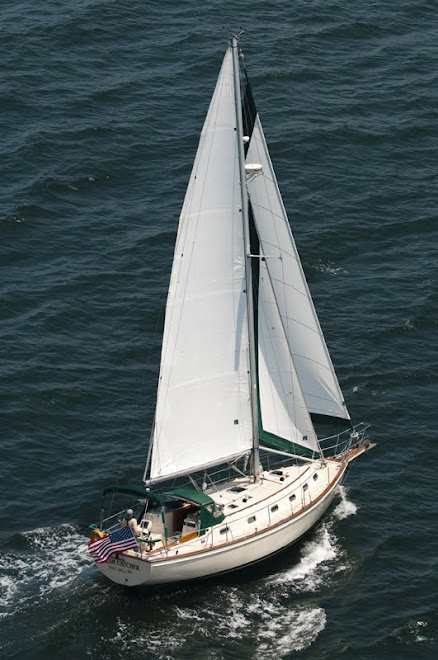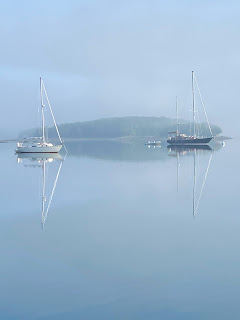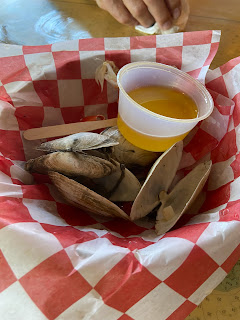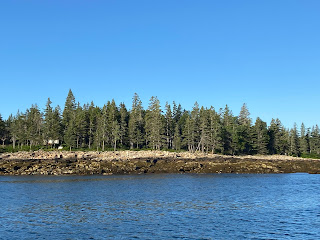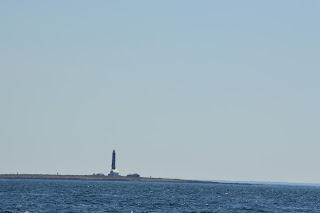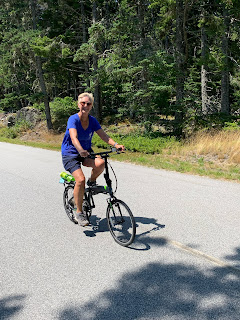The next morning, after the fog cleared, we headed to shore for a walk and the hope of a lobster roll lunch. Our first surprise was finding the Mount Desert Island Historical Society entrenched in the little one-room Sound School House. Built in 1892, the original schoolhouse has been turned into a museum filled with historical information. The staff were very informative folks, always eager to have visitors. The school continues to be used to teach young people and visitors about what life was like back then. In the early 1900's the boys would sit on one side of the room and the girls on the other. The teaching would also focus on different things. The boys would learn about farming, granite mining or boat building. The girls would learn about housekeeping, cooking, sewing or other domestic duties. One curiosity is a practice they currently use when school children come to visit as part of their present day curriculum, they ask each child to choose which gender they want to study. So, instead of making boys learn only about what boys were taught and girls learning only about what girls were taught, each kid chooses what to learn. Interesting! We're pretty sure this would be banned in Florida!
 |
| Thunder Hole with the Park Loop Road in background |
 |
| Mark Island Light (just outside the entrance to Northeast Harbor |
 |
| Those are Bald Eagles |
 |
| Deploying a net to see what they can find |
After our walk, we rewarded ourselves with a lunch of oysters, steamers and lobster rolls. Fabulous!
The next day, in anticipation of high-winds overnight, we headed back down the Sound and into the security of Northeast Harbor. We enjoyed a couple of days plugged into power, used our AC to reduce the dampness, did laundry, and enjoyed the fun offerings in town. Northeast Harbor has a lot to offer in a small, quaint, upscale town. It's got most everything you need, but isn't overrun or too crowded. We found a good bakery (of course!), a decent market, some cute shops and lots of friendly folks. It is also a fairly easy walk to Asticou Gardens on the other side of the harbor and some lovely neighborhoods along the edge of the peninsula. While the weather wasn't as nasty as predicted, we enjoyed being at a dock and drying the boat out.
After a couple days of pleasant walks we headed out early, navigating our way south of MDI, then west around Bass Harbor Head and finally turned north again. This time, our explorations took us up the Western coast of MDI and into Western Bay, a large, quiet bay, with no people and no lobster pots (a real rarity). We enjoyed two relaxing and delightful days there.
 |
| The cables running from shore to the docks at low tide in Northeast Harbor! |
 |
| Scenes from Asticou Gardens |
 |
| Fog rolling into the harbor |
 |
| Finally got a photo - yay! |
As misfortune would have it, we found that our holding tank was leaking and needed to be replaced. We had done this about fifteen years ago in Boothbay. At that time the yard had to cut apart a good bit of the bed and cabinet structure in the forward part of the hull to gain access to the tank, which is under the floor in the forward stateroom. The craftsmen are very good, and replaced everything with screwed panels allowing quick access to the tank this time.
Greg worked tirelessly to source all the parts that were needed. One great benefit he found was from the Island Packet company, who built Dream Catcher. They sent a detailed set of drawings and dimensions of the space, the frames and tank so that the tank builder could recreate an exact replica. They even sent three recommendations of customer tank manufacturers that he then called for estimates of cost and timing.
We chose a company in British Columbia to build the new tank - this time in heavy duty plastic instead of aluminum. After placing that order, Greg lined up Lyman Morse in Camden to do the work. He also spec'd and sourced all the parts needed - hoses, macerator pump, connectors, valves and his favorite - a liquid level gauge that will tell us when the new tank is empty and full. So, so helpful!
So - after a few idyllic days at anchor, we had to head back south and west to get to Camden on time. We enjoyed one more evening at anchor at a favorite spot - McGlathery Island, just south of Stonington. So beautiful!
 |
| McGlathery Island, south of Stonington |
Also unfortunately, we learned that the mom of one of our daughters' closest childhood friends lost her fight with cancer. Because we were able to be within driving distance, we decided we would go to say our last goodbyes. So we headed to Rockland and grabbed a mooring and a rental car to drive to Massachusetts. Fortunately, friends Nancy and Ted, who live near the ceremonies, offered us comfortable and enjoyable accommodations with very short notice. While it was a sad event, we were happy to be able to see our kids (and their kids!), their friends (and their kids!) while there. Bittersweet for sure. Rest in Peace Linda. You will be missed by many!
After returning to Rockland we prepared for a 6am departure the next morning in order to be in Camden by 8am for our work project per our agreement with Lyman Morse. Arriving prior to 8am (as we were asked to do) we had to grab a mooring until another boat on the dock we were assigned to left - 11am checkout. So, having already emptied our berth to allow the techs to work, Greg proceeded to dismantle the structure that holds the bed platform, and do as much as he could to ready the area for the tech. Finally getting our dock space and continuing to do what we could, the tech arrived around 1pm. He did a few things, disconnected some hoses and then got pulled away to another boat just an hour later. He told us he would see us in the morning. So, we cleaned up as much as we could and headed into town for a bit.
The next four days went about the same. The tech - who was excellent at his work - came and went as he split himself between two or three projects going each day. As many of you have most likely also heard, it is just really hard to find help. As low as the unemployment rate is, it still is hard to find anyone who either is trained and needs work or wants to learn a new trade. So, boatyards are working short-handed all the time.
As the project slowly moved along, we discovered that the tank (which we thought we emptied) was still three quarters full. So, we needed to move the boat over to the pumpout dock. While preparing to do this, Greg took a wrong step (on a connector piece of dock that was half as wide as the regular dock) backing up and went into the water. The hardest part was when he tried to get out - there was a portable ladder for that purpose, but it was a fabric one made for a boat and very unstable. It was difficult for him to pull himself up onto a dock two feet above the water in wet clothing. If Sharon hadn't been there, he doesn't think he could have done it. Oh and did we mention that his phone and wallet were in his pockets - the phone he's been carrying around for years with the entire back splintered and cracked - obviously not going to survive a drenching. Now we can say we both went swimming in Maine water - neither by choice!!
So, after a quick shower, off we went to the pumpout dock only to find that the pumpout machine was not pumping! We then had to wait for the harbormaster to show up with his pumpout boat. Sheesh!
Finally, tank empty and back in our assigned dock space, the tech and Greg manhandled the old tank and finally got it out of its space and onto the dock. A tough job for sure!
 |
| This small crack around the valve port is where the tank was compromised |
 |
| The berth before dismantling |
 |
| Behind the storage drawers under the berth - gray tank under |
 |
| The old tank is out, standing on its side |
 |
| The two tanks side by side - they're exactly the same dimensions, only the picture makes the new black one look smaller |
 |
| The new tank in place - yay! |
The new tank finally arrived (two days later than promised) and Greg and Billy wedged it into place. The last of the hose and pump connections finally came together by early Saturday morning, when we could finally pull away from the dock at 10:30am. And yes, the new tank monitor works great!
We headed across the bay for our last night at anchor in Penobscot Bay. We motored through Fox Island Thoroughfare between North Haven and Vinalhaven, and around the bend into Carver Cove on the east side of Vinalhaven. Carver Cove is another very quiet rustic little place that afforded us a clear evening to view the full Milky Way. So very special.
 |
| Carver Cove looking Northeast |
We headed back West next morning, this time into Rockland, where we were scheduled for yet another repair project. This project was a result of damage from winter storage from shrink wrap applied without proper slope to allow snow to slide off the boat. The weight of several feet of snow overwhelmed the steel. As a result, six stainless steel lifeline stanchions had been bent inward from two to four inches. When a mast is left in the boat for the winter, the boom creates a natural high point for a sloped "tent-like" structure. In Maine the custom is for sailboats to have their masts removed for the winter, also removing this slope unless the techs build another out of wood. They did a poor job and this turned out to be a significant problem leading to expensive damage (which the yard picked up, thankfully).
Early Monday morning, the stainless guy showed up with a compressor and his tools. First the lifelines were removed. Then he heated each metal bar and slowly pulled it upright to straight again. Then he polished each piece with an orbital air tool and pumice, then moved on to the next one. When he initially estimated the time for this project he told us he'd need a week. So, the yard and we prepared for a week at the dock set aside for this purpose. It took him only a day! That was good news. It turned out great.
While the stainless steel was being done, Greg started stripping and sanding the toe rail, the six inch wood accent strip along the perimeter of the boat where you step on and off. The old varnish was so bad you could actually peel off pieces by hand. We've been embarrassed by the wood condition for the last two years. But when we asked how much for the yard to redo it, they quoted $16,000! (oh for crying out loud!) We made short work of it in Rockland and got three coats of varnish on by Thursday. While this effort didn't look as beautiful as previous efforts, it looks far better than before. Good work, good result.
Friday morning we start our voyage south towards Newport.
'Til next time -
